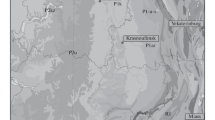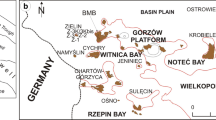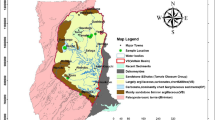Abstract
Lithologically diverse sedimentary complexes were formed within the North and South American platforms. The most general groups of the sediments are distinguished as follows: continental (alluvial, limnic), deltaic, shallow-marine, and deepwater—for the terrigeneous formations, reef limestones and limestones of other origins (oolitic, algaes, etc.), and dolomites—for carbonate varieties. In addition to this, tuffs, tuff-sandstones, and crystalline schists (quartzites) were studied separately. The lasts were marked only in the Permian Basin. The comparative analysis of the sedimentary basins located in the peripheral parts of the North American and South American platforms showed the following: the most important stage in the evolution of the North American platform is the first stage of existence of the ancient Paleozoic continental margins, which developed under passive tectonic conditions and determined its future potential of oil and gas bearing. At this stage, the main resources of oil and gas hydrocarbons are concentrated in carbonate rocks. As for the sedimentary basins located on the margins of the South American platform, the second stage is the most important stage in their evolution when the foredeeps were formed and developed laying on the earlier structures. This period is related to the oil and gas bearing potential of the basins on the margins of the South American platform. For both platforms, a common circumstance is that, at the second stage of development of all the sedimentary basins, all the resources of hydrocarbons are focused in the terrigeneous sediments.The stratigraphic range of oil and gas occurrence in the basins of the ancient continental margins is determined by the following regularity: the fold structures is younger confining these margins, the age range of the oil and gas reservoirs is broader.
Similar content being viewed by others
References
A. Zabanbark, V. G. Kaz’min, and L. I. Lobkovsky, “Ancient continental margins and comparative analysis of their oil-and-gas bearing,” Dokl. Earth Sci. 431 (1), 308–311 (2010).
A. Zabanbark and L. I. Lobkovsky, “The ancient continental margins of the North American and South American plates and regularities in the occurrence of oil and gas accumulations in them,” Dokl. Earth Sci. 442 (2), 220–225 (2012).
Handbook on Oil and Gas Fields in Foreign Countries, Book 1: Europe. Northern and Central America, Ed. by I. V. Vysotskii (Nedra, Moscow, 1976) [in Russian].
Handbook on Oil and Gas Fields in Foreign Countries, Book 2: Southern America. Africa. Middle East. Southern Asia. Central Asia and Far East. Southeastern Asia and Oceania. Australia and New Zealand, Ed. by I. V. Vysotskii (Nedra, Moscow, 1976) [in Russian].
B. E. Khain, Tektonic of Continents and Oceans (in 2000) (Nauchnyi Mir, Moscow, 2001) [in Russian].
P. Baby, R. Limachi, I. Moretti, et al., “Petroleum system of the Northern and Central Bolivian Sub-Andean zone,” AAPG. Mem. 62, 444–458 (1995).
H. D. Klemme and G. F. Ulmishek, “Effective petroleum source rocks of the world stratigraphic distribution and controlling depositional,” AAPG Bull. 75 (12), 1809–1851 (1991).
Northern South America IV. World Shale Gas and Shale Oil Resource Assessment, Annual Report, May 17, 2013, pp. 1–91.
M. Russo, P. Malone, and G. Vergani, “The gas potential of the Sub-Andean basins,” in XXIV World Gas Conference “The Global Energy Challenge: Reviewing the Strategies of Natural Gas,” 2009, pp. 1–34.
P. Soler and T. Sempere, “Stratigraphie, geochimie et signification paleotectonique des roches volcaniques basiques mesozoiques des Indes Boliviennes,” Compt. Rend. Acad. Sci. Paris 316, 777–784 (1993).
A. J. Tankard, S. S. Ramiro, and J. W. Herman, “Petroleum basins of South America,” AAPG Mem. 62, (1995).
G. D. Veiga, L. A. Spalletti, J. A. Howell, and E. Schwarz, “The Neuquen basin, Argentina. A case study in sequence stratigraphy and basin dynamics,” Geol. Soc. Spec. Publ., No. 252, 139–162 (2005).
Author information
Authors and Affiliations
Corresponding author
Rights and permissions
About this article
Cite this article
Zabanbark, A., Lobkovskiy, L.I. Features of the distribution of hydrocarbon accumulations in lithologically different-type deposits at the ancient continental margins of the North American and South American platforms. Oceanology 55, 273–282 (2015). https://doi.org/10.1134/S0001437015020186
Received:
Published:
Issue Date:
DOI: https://doi.org/10.1134/S0001437015020186




